Han (恨) and the Renaissance of Korean Cinema
33 Keys to Decoding the Korean Wave, Hallyu
#5 Country of Trauma, Culture of Drama
Han (恨) and the Renaissance of Korean Cinema
*한류를 이해하는 33가지 코드 #5 한(恨)과 한국영화 르네상스 <한국어 버전, Korean version>
http://www.nyculturebeat.com/index.php?mid=Focus&document_srl=4075077
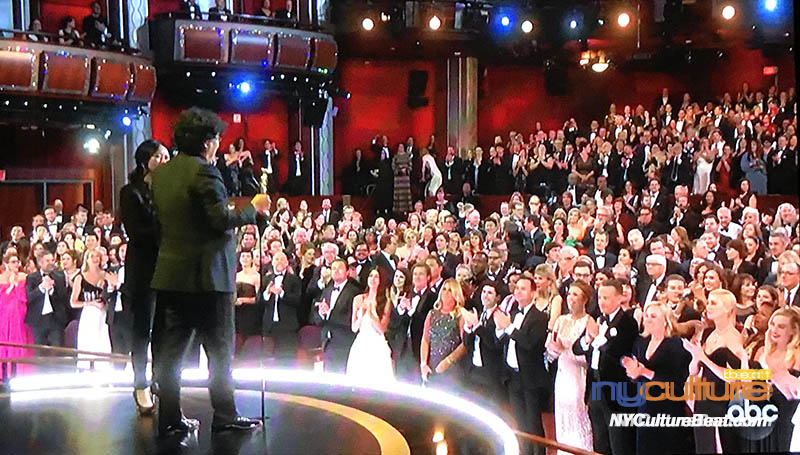
Standing ovation for director Bong Joon-ho, who won the Best International Feature Film award for “Parasite” at the Academy Awards ceremony on February 9, 2020.
"Arirang, Arirang, Arariyo/ You're going over the Arirang Hill/ If you leave me like that/ Your feel will be sore before you get to ten miles
Arirang, Arirang, Arariyo/ You're going over the Arirang Hill/ Just there are many stars in the clear sky/ There is many dreams in our hearts
Arirang, Arirang, Arariyo/ You're going over the Arirang Hill/ That mountain over there is Mt. Baekdu/ Where, flowers bloom even in the winter solstice".
We have our own emotions and illnesses that only Koreans understand. They are “Han(恨)” and “Hwabyeong(火病).” The Korean people have gone through all kinds of battles in their 5,000 year history since Dangun Joseon. As we lived through that hard life, Koreans' hearts were filled with sorrow called Han. The feeling of Han comes from historical events (foreign invasion, civil war, colonization, war, divided country, displacement, separated families, adopted children, etc.); political oppression (dictatorship, corruption, deprivation of freedom, etc.); social (class, Confucian culture of gender inequality, wealth gap, etc.); and personal frustration (college entrance exams, military service, employment, divorce, filial piety, etc.). The emotions of anger, resentment, grief, regret, depression, anxiety, and a sense of defeat accumulated in the heart for a long time. That is, it is the feeling of the weak.
When this Han accumulates in the heart, it becomes a “Hwa-Byeong.” Hwa means "fire" and byeong means "syndrome" or "illness" in Korean.
Hwabyeong is often experience by immigrants. Uprooted from their homeland, making a nest in an unfamiliar land, and starting a second life, they always encounter language barriers, cultural obstacles, and racial discrimination. Here, they live with infinite stress, including permanent residency, rent, medical insurance, and the generation gap with their children. In 1995, the American Psychiatric Association mentioned Hwabyeong as a cultural syndrome that appears in Korean immigrants in the Statistical Manual of Mental Disorders. In English, it is called Somatization Disorder.
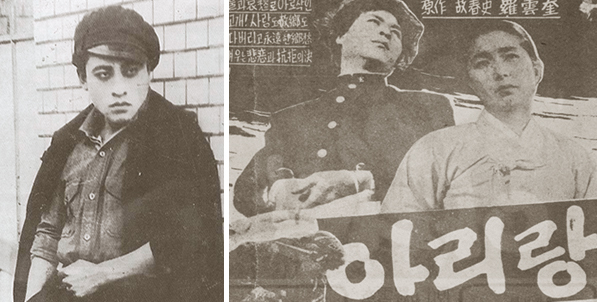
“Arirang,” directed, written by and starring Na Woon-gyu, and produced in 1926, is a film depicting the sorrow of Koreans, and the theme song 'Arirang' has spread widely.
“Arirang” is a song that deeply expresses the Han of our people. “Arirang” was actually the theme song of “Arirang” (1926), a silent film written and directed by and starring Chunsa Na Woon-gyu (1904-1937), who was just 22 years old.
It's a story about a philosophy student, Yeong-jin, who has become mentally ill after being imprisoned and tortured by the Japanese for his involvement in the March 1st protest against the Japanese occupation. He returns to his hometown and stabs and kills with a sickle a pro-Japanese farmhand who was assaulting his younger sister. Yeong-jin awakens from the madness only to be arrested by the Japanese police. In the last scene, the "Arirang" theme song is heard.
“Arirang,” which depicts the wrath and sorrow of the Koreans who lost their country, was released on October 1, 1926 at Danseongsa in Seoul. From the first day of the screening, the Government-General confiscated and repressed 10,000 leaflets, saying they had disturbing lyrics. However, after the release, the theme song “Arirang” spread all over the country and was sung like the national anthem. The movie “Arirang” remained a national film that was re-screened 800 times in Seoul alone over the next 20 years. In an interview with the magazine Samchully in 1937, Na Woon-gyu, the “Orson Welles of Korean Cinema,” said that he had composed "Arirang."
"I wrote it. When I was a young elementary school student, a railroad began to be built from Chongjin to Hoeryong, and then workers from the south sang a sad song 'Arirang, Arirang' while paving the railroad tracks. When I heard that song, I stopped walking and listened to it for a while, and then I memorized the sad and beautiful melody by myself. ... I remembered the melody I had heard before, wrote the lyrics, and asked the Danseongsa Music Band for the song. I made it." -Arirang Archive-
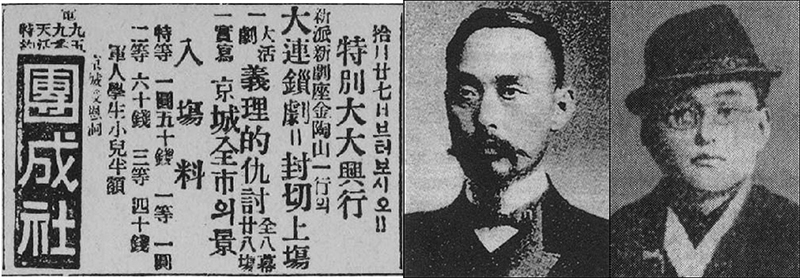
The first Korean movie was “Fight For Justice,” directed by Kim Do-san, which was released at Danseongsa in 1919. Newspaper advertisement and producer Park Seung-pil, director Kim Do-san.
“Arirang” has become a signature song of Korean people's Han. There are about 3,600 variations of 60 different versions of the song handed down across the country, including Jeongseon Arirang, Miryang Arirang, and Jindo Arirang. In 2012, Arirang was registered as a UNESCO Intangible Cultural Heritage of Humanity. However, the film of “Arirang” was lost, and Na Woon-gyu died of tuberculosis at the age of 34. In 1990, the Korean Film Directors Association hosted the Chunsa Film Festival, named after Na Woon-gyu.
In 2019, Korean cinema celebrated its 100th anniversary. Korea's first movie was “Fight for Justice,” directed by Kim Do-san, which was released at Danseongsa on October 27, 1919, under Japanese colonial rule. “Fight for Justice,” which Park Seung-pil, the owner of Danseongsa, invested 5,000 won to produce, was in the form of a kinodrama, a movie inserted between plays.
It was filmed at Han River Iron Bridge, Jangchungdan Park, Cheongnyangri, Namdaemun Station, and Ttukseom, etc. It is the story of Song-san, a son who fights against the wicked stepmother's scheming. Stepmother is the metaphor for Japan, Song-san is Korea. Although the theme is poetic justice, for Koreans, it must have been a film that inherited the national spirit of the 3.1 Movement.
Country of Trauma, Culture of Drama
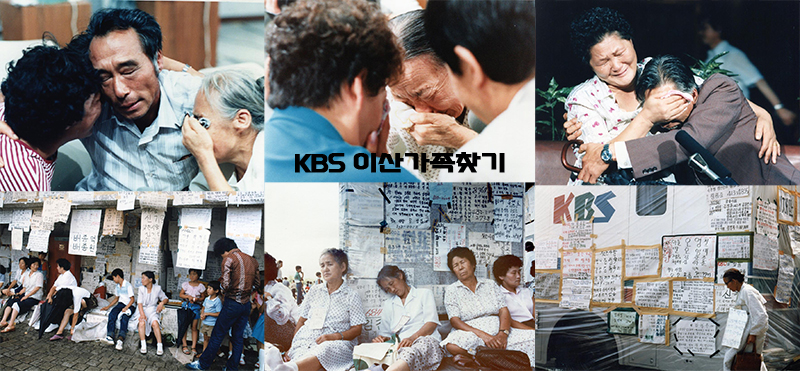
KBS-TV “Finding Dispersed Families” (1983). Photo: KBS-TV
The sorrow of Koreans was amplified in a reality more like fiction than nonfiction. The Korean War (June 25, 1950 – June 27, 1953) left Korean families separated. And in 1983, KBS-TV's special live broadcast of “Finding Dispersed Families” plunged all Korean TV viewers into a sea of tears. The scene where separated families were reunited for the first time, hugging each other and crying, was an unscripted human drama, a dramatic reality show. It was not an interest-based reality program like “Big Brother” or “Survivor” or “American Idol” on American TV. It was a Korean original TV reality show that inspired people around the world with the message of peace, along with the pain and scars of war.
That summer, as a college sophomore, I took a part-time job at KBS-TV Station to organize applications for separated families. I saw abundant documents full of sadness and Han. The main building of KBS-TV in Yeouido was filled with posters looking for families who had been separated.
From June to November of that year, 138 days more than 100,000 applications for reunion were received, 53,536 families appeared on TV, 10,189 families were reunited, and set the record for the longest continuous live broadcast with 453 hours and 45 minutes. The program received international acclaim and humanitarian praise. The recorded tapes, PD notebooks, application forms for dispersed families, and more than 2500 documents, including photos, were registered as UNESCO's Memory of the World Register in 2015.

Director Seung-jun Yi's “In the Absence,” which deals with the Sewol ferry disaster, was the first Korean film to be nominated for an Academy Award for Best Documentary.
On April 16, 2014, Koreans were witnessing the sinking of the Sewol ferry on TV in dismay. The accident, which took the lives of 299 students and teachers, left a deep trauma for Koreans, with emotional shock, sorrow for the victims, anger against the incompetent government and ineptitude of the first responders, and guilt as a survivor. In the end, the Sewol ferry disaster led to the revelations of Park Geun-hye and her friend and advisor, Choi Soon-sil's manipulation of government affairs, and angry citizens started a democratic revolution that impeached Park through candlelight protests.
In our turbulent history, we are a nation that has experienced the drama of reality as devastating as the tragedy of ancient Greece. We who are traumatized are not moved by any drama. Korean TV viewers and moviegoers have high expectations. They are sophisticated critics. They discuss the current hot drama or films on online communities.
The story of an outdated drama or a banal movie is not satisfying. Accordingly, drama and screenwriters have to discover more stimulating, more exciting, reversal and thrilling stories, and directors have to show more outstanding directing skills. Today's Korean dramas and movies have raised their standards by targeting Korean audiences, and they eventually have fascinated people around the world.
Korean Cinema I: Dark Age
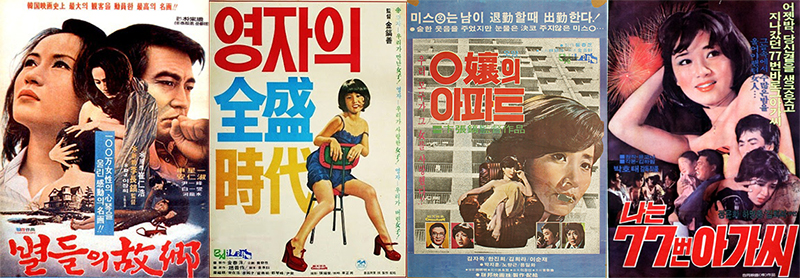
Hostess (barmaid) films poured out under the Yushin regime in the 1970s.
Film is a mirror of society. Not only under the Japanese colonial rule, but also under the dictatorships, the freedom of expression of filmmakers was suppressed and subjected to censorship. After passing through that dark and long tunnel, Koreans are enjoying the joy of the cinema renaissance today.
How did Korea come to have such outstanding Cineastes? For the last 20 years, Korea has become a film powerhouse with directors Bong Joon-ho, Park Chan-wook, Hong Sang-soo, Lee Chang-dong, and the late Kim Ki-duk. However, at one time, Korean films were engulfed in a swamp of darkness with erotic films that were close to pornography. In 1989, I covered the Tokyo International Film Festival, and I had a chance to go to the local videoshop only to find that most of the Korean films were displayed in the erotic video section.
Under the Yushin regime in the 1970s, the Film Act allocated foreign film import quotas to the excellent domestic films. As a result, nationalism-themed films such as “Patriotic Martyr An Jung-gun,” “Filial Piety Simcheong,” “Hot Wind in Arabia,” were pouring out. In a way, Korean film production was the strategic tool to gain import rights of foreign films.
The “7080 Generation,” who spent their 20s in Korea in the 1970s and 1980s, were exposed to folk songs, acoustic guitars, beer, coffee shops, and more. It was a generation that was looking for romantic dates in an American-style steak restaurant. Then, what about the movies? “Ms. O's Apartment,” “The Woman I Abandoned,” “The Woman on Asphalt,” “Heavenly Homecoming of the Stars,” “Winter Woman,” “The Golden Age of Youngja,” “Do You Know Flower Sooni,” “I Am Lady Number 77,” “Manless Street,” and other Hostess (barmaid) movies were popular. Korea's leading directors such as Lee Chang-ho, Kim Ho-sun, Ha Gil-jong, and actresses Jung Yun-hee, Jang Mi-hee, and Yoo Ji-in's Troika enjoyed their heyday with the bizarre genre of hostess.
According to the late actor Shin Seong-il (1937-2018), "In order to avoid censorship at the time, hostesses films, a profession that will not protest, have become the mainstream instead of dealing with the immorality of the upper classes such as professors, lawyers, doctors, and human rights issues of the lower classes such as bus conductors." However, behind the hostess films, there were the structures of labor and sexual exploitation experienced by young country women who moved to Seoul during the industrialization era.
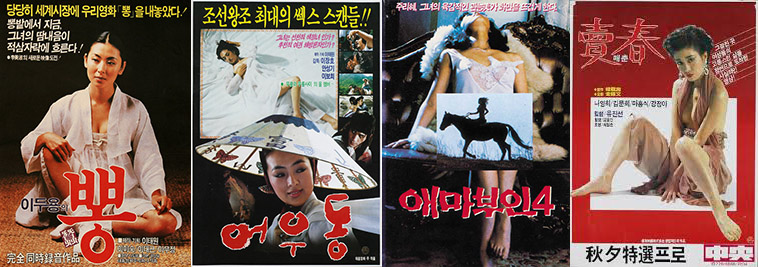
Erotic films were booming in the 1980s of the Fifth Republic.
Sports, Sex, Screen. In the 1980s, the Fifth Republic accelerated to turn the public's attention to the non-political field with the “3S” policy of sports, sex, and screen. In 1982, when the curfew was lifted for the first time in 37 years, the number of brothels surged, and sports newspapers sold like crazy.
In the 80's, Koreans' options for domestic films were very limited. We only could see erotic films such as "Madame Aema," "Eoudong", "Between the Knees", "Night of Burning Flesh and Bones", "Prostitution", "Byeon Kang Soe (Korean Casanova)", "Women Does Not Scare of Night", and "Mulberry", "Red Cherry", "Mountain Strawberries", "Stolen Apples are Delicious", "The Parrot Sings with Her Whole Body", "Does Cuckoo Cry at Night", etc. (*Don't get me wrong, these are not nature science films, they are erotic genre movies.)
The 386 Generation (born in the 60s, politically active in the 1980's) who took the lead in the democratization movement at that time quenched their thirst with a literary film adaptation of the novels of the two authors; political and social novelist Yi Mun-yol ("Son of Man", "Village in the Mist", "Kuro Arirang") or more popular and commercial novelist Choi In-ho ("Flower on the Equator", "Whale Hunting", "Deep Blue Night", Wanderer in Winter"). It was an era when director Lee Chang-ho, who had a socially critical point of view, and director Bae Chang-ho, who was a romantic cineaste, were two top filmmakers. Ahn Sung-ki, the nation's actor, represented cynical intellectuals or weak average citizens in "A Fine, Windy Day", "A Small Ball Shot by a Midget", "People in a Slum", "Whale Hunting", "Village in the Mist", "Our Sweet Days of Youth", "Gagman", "Hello God", "Chilsu and Mansu", and "The Age of Success".
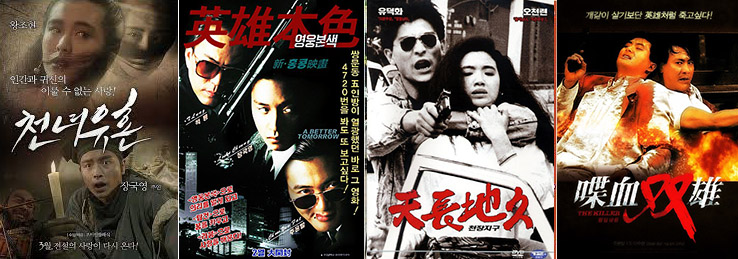
Hong Kong noir and martial arts films were extremely popular when Korean films were in a dark period in the 1980s.
The year I graduated from college with a journalism major in 1986, I worked briefly as a media monitor for the Korean National Council of Women. At the time, Lee Young-hee, chairman of the Korea Public Performance Ethics Committee, showed a compilation of scenes from the movie she had deleted. Even a scene where the female protagonist eats a banana and a construction worker drills a hole in the ground have been cut because it is reminiscent of sexual acts. Director Lee Chang-ho was filming Lee Hyun-se's cartoon "A Daunting Team", but had to change the title to “Lee Chang-ho's Baseball Team”. The original title was rejected by the Committee on the grounds that 'daunting' gives disgust to the public. The Fifth Republic dampened the creative will of filmmakers with “Fearful Scissorhands.”
One day a sports newspaper asked me for a serial column, and the subject was eroticism and movies. I turned it down because it was not my cup of tea. Then the response came, "You are cheeky". (*Please don't insult me, just give me an offer that I can't refuse.) At that time, I was a program committee member with my professor of the top newspaper for its first new media exhibition. We had a meeting every Monday morning for a couple of months. Sometimes we had free hotel breakfast, but we were not paid as committee members. So probably the column offer was for compensation. After all, the serial column was written deliciously by a male screenwriter who used to be a reporter at a movie magazine. Now he is a mystery novel writer and renowned jazz expert in Korea.
Taking advantage of this niche, Hong Kong films dominated in Korean movie theaters, from period martial arts, contemporary film noir, to action comedy. Jackie Chan, Chow Yun-fat, Andy Lau, Leslie Cheung, Joey Wong, Brigitte Lin and Maggie Cheung were among the popular stars. Director Tsui Hark was called "Steven Spielberg of Hong Kong", John Woo was known for stylish crime action and Wong Kar-wai's melancholy images fascinated Korean cinephiles. "A Better Tomorrow" (1986), "A Chinese Ghost Story" (1987), "The Killer" (1989), "To Love With No Regret" (1990), "Swordsman" (1990), "Swordsman II" (1992), the so-called Hong Kong New Wave films dominated the Korean box office for a long time. The situation is completely reversed today.
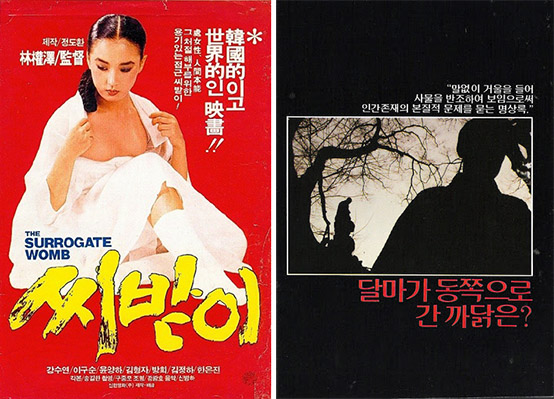
Venice Film Festival's Best Actress Award for Best Actress “The Surrogate Woman” (1987) and Locarno Film Festival's Golden Leopard Award-winning film “Why Has Bodhi-Dharma Left for the East?” (1989).
In June 1987, after the democratic uprising and the 1988 Seoul Olympics, restrictions were lifted and Korean films came out of a long dark tunnel. The late Kang Soo-yeon (1966-2022) became the first Asian actress to win the Best Actress Award at the Venice Film Festival in 1987 and the Nantes Film Festival in 1988 for “The Surrogate Woman” directed by Im Kwon-taek. Chinese actress Gong Li won the Venice Best Actress Award five years later in 1992 for director Zhang Yimou's ”The Story of Qiu Ju.”
In 1989, when Korean director Bae Yong-gyun's Buddhist film “Why Has Bodhi-Dharma Left for the East?” won the Golden Leopard Award at the Locarno Film Festival, a ray of hope poured into the film industry. Bae Yong-gyun, who was a professor of art at Hyosung University, was in charge of producing, directing, scripting, shooting, art, editing and lighting, all by himself. His one-man-band filmmaking inspired many aspiring filmmakers.
With the international recognition of Korean cinema, the creative enthusiasm suppressed by filmmakers in the 1990s began to explode like an active volcano. Senior directors such as Im Kwon-taek, Jang Sun-woo, Kwak Ji-Gyun, Chang Gil-coo, Chung Ji Young, Park Chul-soo, Park Kwang-soo, and Lee Myung-se led Korean films.
Park Chan-wook, who was an assistant director for Kwak Jae-yong's "Watercolor Painting in a Rainy Day" (1989), made his directorial debut with "The Moon Is... the Sun's Dream" in 1992. Starring singer Lee Seung-cheol, the film was a box-office disaster. So, he worked as a film critic for a while and published a book of his intelligent film reviews. And in 1996, Hong Sang-soo, who studied film in the United States, made his first feature film "The Day a Pig Fell into the Well," and received rave reviews. The late Kim Ki-duk (1960-2020), who spent two years as a street portrait painter in Paris, also made his acclaimed debut film " Crocodile" in 1996. Both later became international film festival darlings.
New Waves in the Korean Film Industry
In the year of the 1988 Seoul Olympics, major Hollywood studios started distribution directly to Korean movie theaters through UIP (a joint venture of MGM, UA, Universal and Paramount). The first movie was the romantic thriller "Fatal Attraction," starring Michael Douglas and Glenn Close. The descendants of the "People of Resistance", this time in the film industry, rose again to protest. In 1993, the Korean government announced that the screen quota (mandatory screening days for domestic films) would be reduced from 146 days to 40 days per year. As theater owners would release more foreign films to make a profit, for Korean filmmakers, it was like a death sentence threatening their survival. In 1996, with the revision of the Film Act, the screen quota was fixed at 146 days. As of 2006, the current number has been reduced to 73 days.
In the 1990s, a new wave began in Chungmu-ro (formerly "Hollywood Korea"). Conglomerates such as Samsung, Hyundai, Daewoo, CJ, SKC, Doosan, and Lotte entered the film business with great capital and organizational power. When Steven Spielberg's "Jurassic Park" was released in 1993, President Kim Young-sam said, "The box office revenue of one movie is equivalent to exporting 1.5 million cars." And the government defined the film industry as the high-tech industry of the 21st century. In the mid-1990s, along with the late Professor Kang Han-sup (1958-2021) and Professor Kim Young-jin, I contributed a chapter on “The Impact of Conglomerates on the Korean Film Industry” to a book on the Korean film industry.
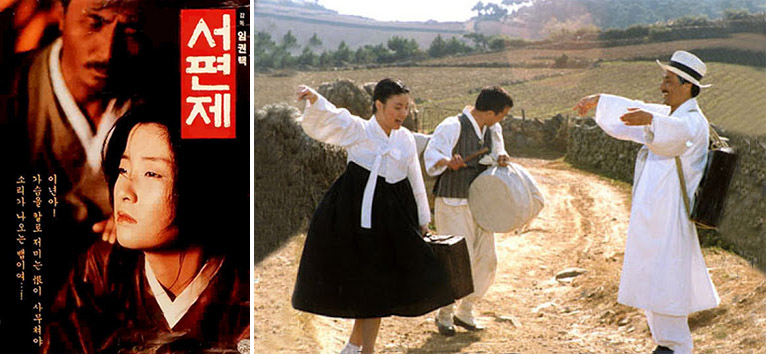
Director Im Kwon-taek's “Seopyeonje” surpassed 1 million viewers for the first time in Korean film history.
"Seopyeonje" directed by Im Kwon-taek
"Han, which is cutting your chest with your arms, must clench for a sound to come out..."
-Kim Myung-gon, "Seopyeonje" (1993)-
Along with this, the era of Executive Producers arrived. Film production and investment were separated as young film planners with careers in film marketing emerged as executive producers, breaking away from the conventional director/producer-centered film production model. In addition, the graduates of the Korean Academy of Film Arts debuted one after another with original scenarios suited to the tastes of young audiences, also breaking away from the filmed adaptation of novels. Shin Cine (Shin Cheol & Oh Jeong-wan) produced "The Marriage Life" (1992) directed by Kim Ui-seok, who graduated from the 1st Korean Academy of Film Arts. It was the first curatorial film, the first romantic comedy, and a box office blockbuster of the year. Master of movie promotion Shim Jae-myung's Myung Film ("Connection", "JSA"), Kang Woo-seok's cinema service ("Two Cops", "Number 3"), Cha Seung-jae's Uno Film/Sidus ("Christmas in August", Beat") were the game-changers of the Korean cinema.
And a Korean film surpassed 1 million viewers at the box office. Director Im Kwon-taek, who achieved commercial success with "The General's Son 1 and 2", set the first record of drawing 1 million viewers with his 1993 film "Seopyeonje," opening up the commercial possibility of artistic films. "Seopyeonje" was released at Danseongsa Theater, where the history of Korean cinema began. And it became a national film that sparked interest in Pansori, the Korean traditional one-person opera. It is no coincidence that “Seopyeonje” deals with Pansori, wandering artists, and Han, our unique sentiment.
Actor Han Seok-kyu was the King of the Korean film box office in the 1990s. He maintained his superstardom with blockbuster films such as "Doctor Bong", "The Ginkgo Bed", "Blue Fish", "No. 3", "The Contact", "Christmas in August", "Tell Me Something", and "Shiri". Following the hostess films of the 1970s and the helpless intellectuals of the 1980s, the 1990s saw the rise of male action movies. On the other hand, the young generation who grew up reading film magazines RoadShow and Kino, in which the influential critic Jung Sung-il served as the editor-in-chief, became keen cinephiles armed with cinematic knowledge comparable to critics. Director Park Chan-wook was also a serious critic for the magazines. They are now witnessing today's renaissance of Korean cinema.
Korean Cinema III: Renaissance
Censorship has hindered the development of Korean films since the Japanese colonial period. After the democratic uprising in June 1987, the screenplay pre-deliberation was abolished, and in 1996, when the film pre-deliberation was ruled unconstitutional, censorship disappeared. After that, for the first time in the history of Korean cinema, filmmakers were able to unleash their creative freedom.
In the 2000s, Conglomerates entered Chungmu-ro for the second time, gaining vitality. In the early 1990s, large corporations entered the market, but in 1997, they faced the rock of the Financial Crisis. In the 2000s, Cheil Jedang (CJ Entertainment), Orion Group (Megabox), and Lotte Group (Lotte Entertainment) managed the overall film business, including film production, investment, distribution and theater.
In 2000, Park Chan-wook and Bong Joon-ho rose to the horizon. Park recovered from the box office disasters of his debut (“The Moon Is ... the Sun's Dream,” 1992) and his second (“Trio,” 1997), and became a hitmaker with huge success of “Joint Security Area” (2000). And Park becomes a master of brutal aesthetics with his "Revenge Trilogy" (“Sympathy for Mr. Vengeance,” 2002/ “Oldboy,” 2003/ “Lady Vengeance,” 2005). Meanwhile Bong made a quiet debut with the black comedy "Barking Dogs Never Bite" (2000), which didn't get much attention by critics nor audience at the time. But Bong rose to a future master filmmaker with "Memories of Murder" (2003) and "The Host" (2006).
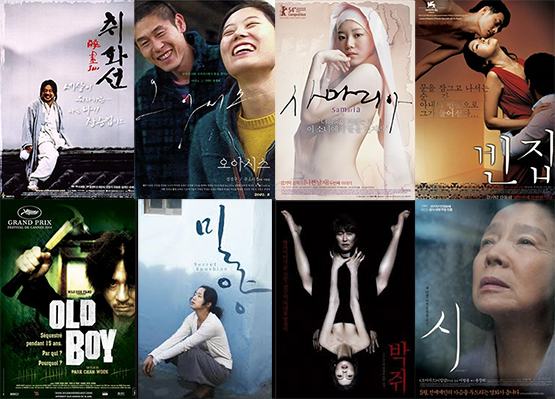
In the 2000s, directors Im Kwon-taek, Lee Chang-dong, Kim Ki-duk and Park Chan-wook, and actor Jeon Do-yeon won awards one after another at the three major international film festivals in Cannes, Venice and Berlin.
In the 20 years since 2002, Korean films have achieved a renaissance in the world's three major film festivals, such as Cannes, Venice, and Berlin. Director Im Kwon-taek, whose two films gave the late Kang Soo-yeon the Best Actress Award at Venice for "The Surrogate Woman" in 1987 and Best Actress at the Moscow Film Festival for "Come Come Come Upward " in 1989, finally won the Best Director Award at the Cannes Film Festival for “Painted Fire/ Chwihwaseon” in 2002. In Venice in 2002, Lee Chang-dong won Best Director (Silver Lion) and actress Moon So-ri won the Best New Actress award for "Oasis", and the golden age of Korean cinema has begun.
In 2004, Korean films swept the major awards of the three major international film festivals. Director Kim Ki-duk won the Berlin Best Director (Silver Bear) for "Samaria" and the Venice Best Director (Silver Lion) for "3-Iron", while Park Chan-wook won the Grand Prix for "Old Boy" at Cannes.
In 2007, exactly 20 years after the late Kang Soo-yeon took the Best Actress Award at Venice, Jeon Do-yeon won the Best Actress at Cannes for her performance in "Secret Sunshine" directed by Lee Chang-dong. In 2008, director Jeon Soo-il received the Venice Artistic Contribution Award for "With a Girl in Black Land," and in 2009, Park Chan-wook returned to Cannes to receive the Jury Prize for "Thirst".
In 2010, Lee Chang-dong won Best Original Screenplay for "Poetry" at Cannes, and in the same year, Hong Sang-soo took home the Un Certain Regard award at Cannes for "Hahaha". And the following year, Kim Ki-duk also took the Un Certain Regard at Cannes for "Arirang". In 2012, director Kim Ki-duk won the Best Picture (Golden Lion) at the Venice Film Festival for 'Pieta', recording the first grand prize in Korean film history. In 2017, Kim Min-hee won the Best Actress Award at Berlin for Hong Sang-soo's “On the Beach at Night Alone.” Together, Korean actresses, including the late Kang Soo-yeon (1987, Venice), Jeon Do-yeon (2007, Cannes), and Kim Min-hee (2017-Berlin),conquered the Best Actress Awards at the world's top three film festivals.
The best was yet to come. In May 2019, director Bong Joon-ho won the Palme d'Or at the Cannes Film Festival for “Parasite,” and the enthusiasm led to the film winning the quadruple crown (Best Picture, Original Screenplay, Director and International Feature Film) at the Academy Awards in February 2020, renewing the history of Korean cinema. And Berlin dedicated a prize to Hong Sang-soo for three consecutive years. In 2020, "The Woman Who Ran" won Best Director, Hong won Best Screenplay for "Introduction" in 2021, and in 2022, Hong was the winner of the Jury Grand Prize for "A Novelist's Film".

Since 2000, gangster movies have flourished in Korea, opening the era of 10 million viewers.
Unlike Hollywood, where movie performance is based on ticket sales, in Korea, the number of audience attendees is counted. In the 2010s, films dealing with gangsters dominated Korean filmmaking and enjoyed their heyday. "Friends'' (2001), "Kick the Moon'' (2001), "My Wife is a Gangster'' (2001), "Marrying the Mafia'' (2002) and "A Dirty Carnival" succeeded at the box office.
Does a gangster film reflect the aspirations of weak Korean men without confidence? Is it a satire for a corrupt society? In any case, the era of 10 million cinema audience arrived at this time. This is thanks to the opening of the multiplex theaters at the same time. After “Silmido” directed by Kang Woo-suk reached 10 million viewers in 2003, other Korean films attracted large numbers, including "Taegeukgi" (2004), "The King & The Clown" (2005), disaster flicks "The Host" (2006), and "Haeundae" (2009), all “Alpha Male” style blockbusters.
In 2013, directors Park Chan-wook, Kim Ji-woon, and Bong Joon-ho, whose box office and artistic prowess were praised, went to Hollywood. Park made the mystery thriller "Stalker" starring Nicole Kidman, Kim Jee-woon directed the western "The Last Stand" starring Arnold Schwarzenegger, and Bong debuted in Hollywood with a dystopian thriller "Snowpiercer" starring Chris Evans, Tilda Swinton and Song Kang-ho.
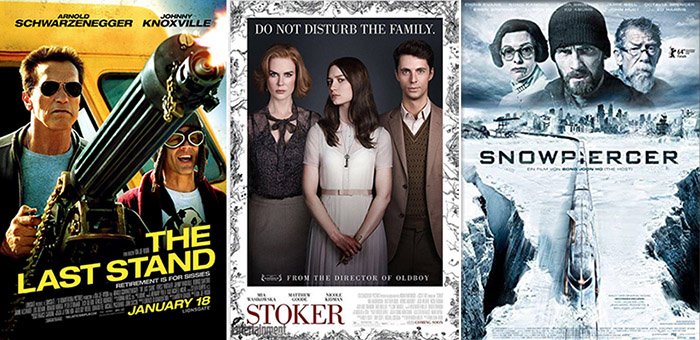
Director Kim Ji-woon, Park Chan-wook, and Bong Joon-ho made films in Hollywood in 2013.
On the other hand, the front line of Korean box-office films was dominated by action and thrillers such as "The Unjust" (2010), "I Saw the Devil" (2010), "Nameless Gangster: Rules of The Time" (2012), "Ode to My Father" (2014), "Inside Men" (2015), "The Age of Shadows" (2016), and "Train to Busan" (2016).
Actor Song Kang-ho started with a minor role in Hong Sang-soo's debut film "The Day a Pig Fell Into the Well" (1996). He has become a national actor having worked with auteur filmmakers such as Lee Chang-dong (“Green Fish,” “Secret Sunshine”), Park Chan-wook (“Joint Security Area,” “Sympathy for Mr. Vengeance,” “Thirst”), Bong Joon-ho (“Memories of Murder,” “The Host,” “Snowpiercer,” “Parasite”), and commercial directors such as Kim Jee-woon (“The Quiet Family,” “The Foul King,” “The Good, The Bad, The Weird,” and “The Age of Shadows”). On the other hand, Lee Byung-hun made his career as a highest grossing box office star in "Masquerade", "The Fortress", "The Age of Shadows" and "Inside Men". Lee emerged as a global star after appearing in Hollywood movies such as "G.I. Joe: Retaliation", "RED 2" and "Terminator Genisys".
However, the decade of the Lee Myung-bak and Park Geun-hye Presidential regimes (2008-2017) brought the cultural world back into darkness. The governments created a blacklist to suppress cultural artists who were critical of the regime. Among the 9,500 people on the blacklist were Bong Joon-ho, Park Chan-wook, Lee Chang-dong, Hwang Dong-hyuk, and Kim Ji-woon.

Under the Lee Myung-bak & Park Geun-hye administrations, historical films that promoted patriotism were pouring out.
As a result, the number of historical drama films dealing with the Byeongja Horan, the Imjin War, the Gwanghae Army, the Provisional Government of Shanghai, and the Korean War, which can be freed from censorship, increased rapidly. It is no coincidence that historical films that inspire patriotism such as "War of the Arrows" (2011), "The Front Line" (2011), "Masquerade" (2012), "Roaring Currents" (2014), "Ode to My Father" (2014), "Assassination" (2015), "Battle for Incheon: Operation Chromite" (2016), "The Age of Shadows" (2016), "The Last Princess" (2016), "Dongju: The Portrait of a Poet" (2016), "A Resistance" (2019), and "The Battle: Roar to Victory" (2019) poured in.
The Park Geun-hye and Choi Soon-sil Scandal burned with a candlelight civil protest, which led to the impeachment of President Park on March 10, 2017. In addition, Kim Gi-chun, former chief of the Blue House Secretariat, and Cho Yun-seon, Minister of Sports and Tourism, who conducted the blacklist, were removed from power.
Korean Cinema IV: "Parasite" and After
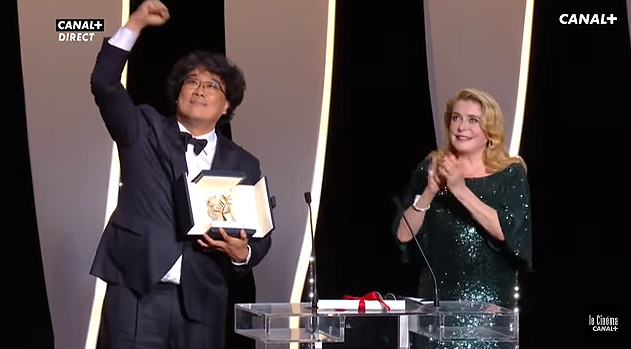
Director Bong Joon-ho, achieved a first in 100 years of Korean film history, by winning the Palme d'Or at the Cannes Film Festival for “Parasite.” The award was presented by French actress Catherine Deneuve. Photo: YouTube
After the inauguration of the Moon Jae-in government in May 2017, the era of thawing between the two Koreas began, and the culture and art world also found stability. The blacklisted director, Bong Joon-ho, who made "Snowpiercer" (2013) and "Okja" (2017) in Hollywood, returned to Korea and made "Parasite" and won the Palme d'Or at the 2019 Cannes Film Festival. It was a splendid feat 100 years after Korea's first movie “Fight for Justice" (directed by Kim Do-san) was screened in 1919. And, at the 2020 Oscars, Bong Joon-ho & Co. swept the Best Picture, Director, Original Screenplay, and International Feature Film Awards, rewriting the Academy Award history as well as Korean film history.
In January 2020, Korean-American director Lee Isaac Chung's autobiographical film “Minari,” which tells the story of Korean immigrants, won the Grand Jury Prize and Audience Award at the Sundance Film Festival. About a month later in February, it became a "Parasite" party at the Academy Awards. It is a historic event in which two Korean films swept the American mainstream Hollywood (Academy Award) and independent films (Sundance) in the US in 2020. And “Minari” was submitted to the Academy Awards the next year.
Hollywood star Brad Pitt's production company, Plan B Entertainment, produced the $2 million independent film "Minari". In 2021 "Minari" was nominated for six categories: Best Picture, Best Director, Best Original Screenplay (Lee Isaac Chung), Best Actor (Steven Yeun), Best Supporting Actress (Youn Yuh-jung), and Music (Emile Mosseri) at the Academy Awards. Youn Yuh-jung received an Oscar and became the first Korean actress to win, at the age of 73. Youn also won more than 40 awards, including the SAG Awards/Screen Actors Guild Award and the British Academy Award (BAFTA).
On September 17, 2021, Netflix's Korean drama "Squid Game", directed by Hwang Dong-hyuk, first aired. And in the next seventeen days, 111 million people around the world watched it, becoming a blockbuster hit. In February 2021, at the 28th Screen Actors Guild Awards (SAG), the "Squid Game" team swept and made history again, this time for a TV-Drama Series. Lee Jung-jae won the Best Actor and Jung Ho-yeon won the Best Actress Award, and stunt actors won the new Stunt Ensemble Award. It is the first time that an actor from a non-English-speaking drama (*"Parasite" was in the movie category) has won the SAG Award. Lee Jung-jae and Jung Ho-yeon will rise to global superstardom. Also, Oh Young-soo who played the role of Oil Nam, won the Golden Globe Award for Best Supporting Actor, at the age of 77.
For three consecutive years. two Korean films and a drama conquered the Mount Everest of movies with "Parasite," "Minari'' and "Squid Game''. Minari, water parsley that Koreans use for cooking, and Squid, nostalgic Korean games for kids, spread all over the world with the success of the film and the drama.
At the 75th Cannes Film Festival in 2022, Korea created a sensation again. Director Park Chan-wook's mystery thriller "Decision to Leave" won the Best Director Aware, making his third Cannes Award after Grand Prix in 2004 for "Oldboy" and the Jury Prize for "Thirst" in 2009. And Song Kang-ho won the Best Actor for "Broker" directed by Japanese Hirogazu Kore-eda. became the first Korean male actor to receive the award.
Sukie Park
A native Korean, Sukie Park studied journalism and film & theater in Seoul. She worked as a reporter with several Korean pop, cinema, photography and video magazines, as a writer at Korean radio (KBS-2FM 영화음악실) and television (MBC-TV 출발 비디오 여행) stations, and as a copywriter at a video company(대우 비디오). Since she moved to New York City, Sukie covered culture and travel for The Korea Daily of New York(뉴욕중앙일보) as a journalist. In 2012 she founded www.NYCultureBeat.com, a Korean language website about cultural events, food, wine, shopping, sightseeing, travel and people.

33 Keys to Decoding the Korean Wave, Hallyu
Beyond BTS, Parasite & Squid Game
CONTENTS
#Prologue: 국풍인가, 국뽕인가 Dynamic Korea, Sparkling Koreans
#1 비빔밥 정신 The Spirit of Bibimbap
#2 빨리빨리 문화 The Culture of ppalli Ppalli
#3 눈치의 달인들 Homo Nuncius Korean
#4 저항의 민족 People of Resistance
#5 한(恨)과 한국영화 르네상스 Country of Trauma, Culture of Drama
#6 쇠젓가락 유전자 The Magic of Metal Chopsticks
#7 세탁의 장인들 Masters of Laundry
#8 복(福)을 싸드립니다: 보자기, 보따리와 보쌈 Bojagi, Bottari, Bossam
Joseon, Corea, Korea
#10 호머 헐버트와 세계인들의 한글예찬 Hangul, the Korean Alphabet
#11 '오징어 게임'과 '놀이의 왕국' 코리아 'Squid Game' and Homo Ludens Koreans
#13 음주가무-먹고 Eat
#14 음주가무-마시고 Drink
#15 음주가무-노래하고 Sing
#16 음주가무-춤추고 Dance
The Power of Koreans
#17 미 태권도의 대부 이준구 대사범 The Father of American Tae Kwon Do, Jhoon Rhee
#20 82년생 김지영 도서 한류 열풍 K-Books and Korean Feminism
#24 '비디오 아트의 선구자' 백남준과 후예들 Nam June Paik and His Descendants
#25 K-클래식: 정경화에서 임윤찬까지 콩쿠르 강국 The Korean Musical Mystery
#26 비틀즈 Vs. 방탄소년단 The Beatles vs. BTS
#27 입양한인 예술가들 K-Adoptees Shine in the Art World
K-Culture Renaissance
#28 K-Food 한식 엑스타시 The Wide Spectrum of Korean Taste Buds
#29 K-Art 단색화 부활하다 The Revival of the Korean Monochrome Painting
#31 K-Beauty 성공신화 The Myth of K-Beauty
#32 K-Spa '한국 스파의 디즈니랜드' 찜질방 Jjimjilbang, The Disneyland of Korean Spa
#33 K-Quarantine 기생충, 킹덤과 코로나 팬데믹 K-Quarantine: 'Parasite' 'Kingdom' and Pandemic
#Epilogue




 혼족(Aloners: 혼자 사는 사람들)이라는 로망을 꿈꾸신다면... ★★★★
혼족(Aloners: 혼자 사는 사람들)이라는 로망을 꿈꾸신다면... ★★★★
 Summer Movies (1) 6월의 영화: 개봉작 24편 가이드
Summer Movies (1) 6월의 영화: 개봉작 24편 가이드

